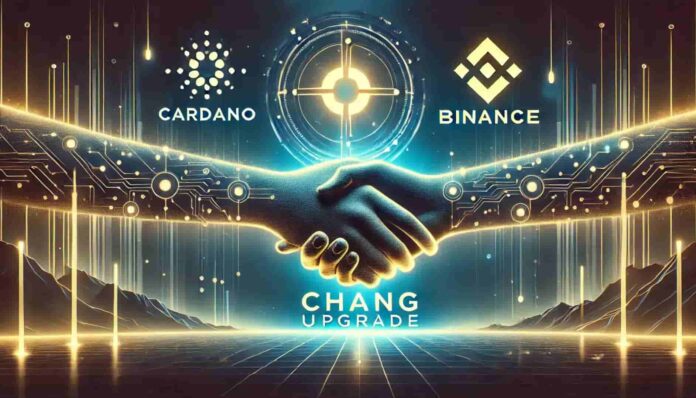The world of blockchain technology has witnessed a significant shift with the recent activation of Cardano’s highly anticipated Chang upgrade. This milestone event marks a pivotal moment in the ecosystem’s journey towards decentralized governance, empowering the community to shape the future of the ADA cryptocurrency and the Cardano blockchain.
Launched in 2017 by Ethereum co-founder Charles Hoskinson, Cardano has consistently been at the forefront of innovative blockchain developments. The Chang hard fork, a critical upgrade that introduces a new era of on-chain governance, is a testament to the platform’s commitment to decentralization and community-led governance.
Cardano’s Shift Towards Decentralized Governance
The Chang upgrade has ushered in a transformative shift in Cardano’s governance structure. ADA Cardano token holders now have the power to actively participate in shaping the blockchain’s future by electing governance representatives and voting on development proposals. This governance transition is a significant step towards aligning Cardano with the decentralized ethos that underpins the broader blockchain industry.
More Article: Shibarium Fees Surge by 1,036% Amid Surge in Shiba Inu Activity
The New Governance Model
The Chang hard fork has established a comprehensive token-based governance system, as outlined in the official Cardano Improvement Proposal (CIP-1694). This framework introduces three user-led governance bodies: the Constitutional Committee, Delegate Representatives (dReps), and Staking Pool Operators (SPOs). These entities will now be responsible for triggering chain upgrades and hard forks, a role previously held by Cardano’s founding organizations – the Cardano Foundation, Input Output Global (IOHK), and Emurgo.
Empowering the Community
The implementation of this new tricameral model is being rolled out in two phases. The first phase, already live on Cardano, introduces an Interim Committee to temporarily oversee Cardano’s governance. This phase is designed to be cautious, limiting the committee’s power to make changes to the blockchain’s code while the rest of the ecosystem’s governance model takes shape.
The second phase, expected to unfold within the next 90 days, will fully empower the new governance bodies. “Once everyone is onboard and well-informed, they will be ready to actively participate in governance,” explained Giorgio Zinetti, CTO of the Cardano Foundation, in an interview with CoinDesk.
Read More: Navigating Crypto Regulation in Australia: A 2024 Guide
Cardano’s Positioning in the Blockchain Landscape
The Chang hard fork represents a significant milestone in Cardano’s roadmap, marking the beginning of the Voltaire era – a phase focused on achieving full decentralization that has been in the works since the blockchain’s inception. This blockchain evolution showcases what Cardano cryptocurrencies are capable of achieving.
Differentiating from Other Blockchains
Cardano’s transition towards on-chain governance sets it apart from many other blockchain projects, even major ones like Bitcoin. “I think we are the largest layer 1 with on-chain governance,” Zinetti stated. “There are some smaller players, like Tezos and Polkadot, who already have on-chain governance. But if there was a leaderboard, real decentralized layer-1s, we would be number one.”
Addressing Securities Regulators’ Concerns
The implementation of decentralized governance may also be viewed as a strategic move by Cardano to ward off potential scrutiny from securities regulators. By bestowing the ADA governance token with additional utility and decision-making power, the platform aims to strengthen its position as a decentralized ecosystem, potentially mitigating any concerns about ADA being classified as a security.
Navigating the Challenges of Decentralization
While the shift towards decentralized governance is a significant step forward for Cardano, it is not without its challenges. Decentralized Autonomous Organizations (DAOs), which have gained traction in the crypto space, have faced criticism for issues such as excessive budgets, inadequate checks and balances, and the concentration of power among a few influential stakeholders.
Avoiding the Pitfalls of DAOs
Cardano’s new governance model is designed to address these concerns. The tricameral system, comprising the Constitutional Committee, dReps, and SPOs, aims to ensure that all important stakeholders have a voice and that appropriate checks and balances are in place. This approach is intended to avoid the pitfalls often associated with traditional DAO structures and solve the UTXO problem that has plagued some other blockchains.
Engaging the Community
However, the success of Cardano’s decentralized governance will ultimately depend on the active participation and understanding of the ADA token holders. Involving thousands of community members, many of whom may not be fully versed in the intricacies of the new system, could present challenges in terms of managing expectations and ensuring meaningful engagement. Cardano will need to focus on education and outreach, perhaps through initiatives like a hard fork podcast, to keep the community informed.
Conclusion
Cardano’s Chang hard fork marks a pivotal moment in the platform’s history, ushering in a new era of decentralized governance. By empowering ADA token holders to steer the blockchain’s direction, Cardano is taking a significant step towards aligning with the core principles of decentralization that have long been at the heart of the blockchain industry.













